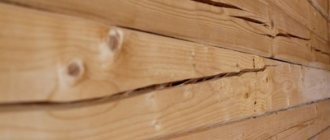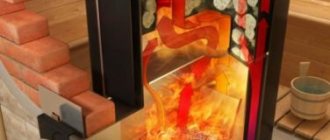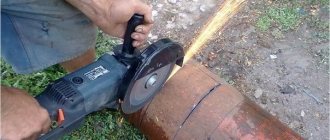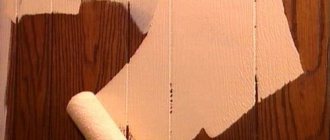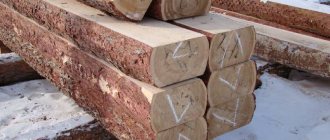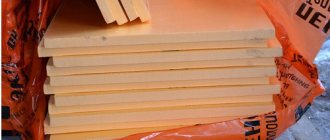Hello, authors and site experts!
My name is Sergey, and I have the following question. Six months ago, I partially covered the inside of my country house with clapboard, and recently I noticed that in some places the paneling literally stood up like a “house.”I can’t imagine what the reason could be and how to properly fix the problem. In general, tell me why the lining swells and how to deal with it. Thanks in advance!
How to lay the lining so that it does not lose its shape and lasts for a long time
Reply to reader
Greetings, Sergey!
We are always happy to help our readers with any problems they may have, and we try not to miss every such request. There is only one solution to the problem, although the ways of its implementation may differ - we will talk about this a little later, but now let's figure out why the casing can swell.
Wood and its properties
We know that wood is heterogeneous in its structure, which directly affects its properties. For example, moisture enters it from the air mainly across the trunk, and is removed along it. It is this property that allows the construction of log houses from logs and beams without organizing ventilation. The lining, due to its dimensions, is practically deprived of this property, however, it is still capable of removing excess moisture from the room.
Having absorbed a certain amount of water, the wood begins to change in size - mainly along the grain. This feature determines some rules when installing this material.
- The lamella itself (lining board) has a certain profile designed for a tongue-and-groove connection. Its groove is always deeper than the tenon, so that there is space for ventilation and thermal expansion of the material. However, when installing the lining, you still shouldn’t hammer the lamellas too tightly into each other - usually the connection is not completed by 2-3 mm. This requirement should be followed especially clearly in particularly damp and warm rooms, for example, saunas and baths.
- Not all types of wood are equally susceptible to moisture. The denser its structure, the slower the process, which is why these varieties are chosen for finishing wet rooms (linden, abashi, aspen, cedar).
- This parameter is greatly influenced by the degree of dryness of the wood. The better it is dried, the less likely it is that warping will begin over time.
Advice! In general, changes in temperature and humidity cause many materials to change in size, so these indicators are always taken into account during repairs and construction.
Reasons for swelling of clapboard sheathing
The defect looks like a wave consisting of two or more lamellas. And as luck would have it, it most often appears not somewhere in an inconspicuous place, but in the middle of the wall. The reason for this phenomenon, as we have already found out, lies in a change in volume, which, in turn, can be caused by various factors.
- In 90% of cases, the reason is the use of natural humidity when covering the lining. Such wood does not need strong changes in temperature and humidity in order to respond to the environment by changing its geometry. Very often it is country houses that suffer, which are not heated in winter. The reason is that wet wood does not have the reserve volume for additional absorption that dry wood does.
- The second reason why swelling occurs at normal humidity levels is the installation method, as we discussed earlier. If the boards are fitted too tightly, then the expanding tree (this can happen after turning on the heating) can literally tear out the fastener “with its roots”, or it can crack if the fastening is too secure.
- If a similar picture is observed on the ceiling, then the culprit is often the accumulation of moisture behind the cladding (sometimes such incidents also happen with walls). Moisture can appear on the ceiling for various reasons: poor steam or waterproofing, condensation in the absence of insulation - this can only be determined on the spot by disassembling the casing and looking under it. In this case, no measures will help until these shortcomings are eliminated.
- A similar effect can occur if there is insufficient ventilation behind the sheathing. Lack of air movement also causes wood to warp.
Warping and drying out
Lining is a material made from solid wood, unlike fibreboards or siding, while retaining all the advantages of wood, it has the same disadvantages. It is precisely such a useful quality as the creation of a microclimate that is the cause of severe deformations.
If we are talking about a log or a thick rounded beam, the appearance of such defects does not affect the usable qualities: as soon as the humidity increases, the tree, having gained the required amount, will return to its original state. But with clapboard the situation is different.
Boards of small width react differently: they bend along their length in different directions, decrease in volume, and as a result become detached from each other, forming gaps between the lining. This process is especially noticeable in unheated rooms when warm weather sets in.
The same process occurs on the balcony, terrace, facade and so on. The lining itself does not create gaps, but the distances between the slats can be considerable. Sometimes it’s not easy to close them up.
The second reason is essentially a continuation of the first. In the vast majority of cases, poorly dried wood cracks. After installation, it is “dryed” on the ceiling of the room or in the steam room, which, of course, can hardly be called favorable conditions for this. As a result, the material warps and the surface loses its integrity, as in the presented photo.
How to seal cracks in lining
Several methods are used. Their effectiveness depends on the amount of damage and operating conditions of the premises. What to do in such cases.
Solid oil - the composition includes linseed oil, turpentine and rosin, designed for floorboards, but can help in this case too. However, they “treat” lamellas that have just begun to warp. The product prevents the active absorption of moisture and prevents the wood from swelling.
What to do if the process has already gone quite far, and the lining has dried out considerably? You can use wood putty. The composition fills defects and holes, forming a dense, but not hard mass. After drying, the putty is sanded with sandpaper, painted or varnished.
The method is not suitable for unheated rooms. The difference in coefficient of thermal expansion between materials is too great. If the house does not warm up in winter, the putty will crumble the next season.
How to seal the gaps between the lining if the putty is not suitable? A composition of small shavings obtained by sanding wood with sandpaper and PVA glue is used. The coefficient of thermal expansion of this composition is much closer to wood; the material swells and dries along with the lamellas. Instead of glue, you can use wood varnish.
The composition is prepared in small portions, as it sets quickly. Apply with a spatula into the seams between the lamellas and lightly compact. After drying, the surface is treated with paint or varnish.
Corrective Action
So, how can you correct the situation with your own hands?
In fact, the instructions for action are extremely simple, but they will require time and some effort. The price of work when hiring a specialist can be quite high, since usually no one wants to take on alterations - you just have to fix everything yourself.
- There are two methods, but they differ only in that they will need to expand different areas of coverage.
- In the first case, the sheathing is removed from the corner, right down to the last raised lamella. As you understand, you will have to tinker a lot, not only during dismantling, but also during reassembly. Inspect the curved panels carefully; perhaps it is better to reuse them somewhere closer to the corner, so that if something happens, you do not have to repeat the jointing again.
- Reassemble the surface, carefully checking the expansion gaps between the boards. Most likely, the end panel will not fit into place and will have to be cut to width. Use clamps and self-tapping screws as fasteners.
- The second method will also require jointing, but only the swollen area. Technically, it is more difficult to complete, since you will have to trim the lining tenons a little. Then the boards need to be tucked back in, which is not always possible. To fix the elements you will have to use either nails or self-tapping screws.
Advice! If the cause of swelling lies in excess moisture of the material, then before reinstalling it, it must be dried.
That's all! Now you know why the lining swells, and you can return the lining to its original appearance, taking into account the necessary details. This video in this article will also help you.
Wooden finishing slats - the material is so versatile that it is used for cladding almost any living and working premises: in the country house, in the bathhouse, on the balcony and in the bedroom. However, in order for such a finish to last a long time, it is necessary to choose the right material and secure it correctly.
Wood is heterogeneous in its structure. This means that the manifestation of certain qualities depends on the direction of effort. For example, moisture from the air is more actively absorbed across the trunk, and removed along the trunk, which allows the log house to do without ventilation - this role is performed by the tree itself.
Lamels - boards cut from a trunk, mostly lose this feature, but even the thinnest lining can remove excess moisture from the room.
However, when wood absorbs moisture, it changes in volume, unevenly, and along the grain. Hence the first strict requirement when installing products.
- The lining is not laid tightly. Do not drive the tenon into the groove all the way; there must be a technical gap of 1–3 mm, otherwise the board will swell. This condition must be observed especially strictly in the bathhouse, where the humidity and temperature are high.
Moisture absorption and removal rate depend on many factors.
- Wood species - aspen and linden, for example, are not prone to swelling, which is why they are used for finishing in the bathhouse. But poplar and birch are prone to warping.
- Sections of the trunk - when cutting, the boards turn out to be cut from different places of the trunk. As a result, their ability to expand turns out to be different: a board with a tangential cut expands by 9–15%, a board with a radial cut – by 5–10%.
- Degree of drying - the lining is produced with natural humidity, that is, air-dried, and dry with a humidity level of 8–12%. To do this, the latter is dried in drying chambers. The drier the wood used, the lower the likelihood that the lining will swell.
Wood is not the only material that changes in volume as temperature changes. In all such cases, laying involves non-rigid fastening so that the material has room to change in length.
The deformation looks like a wave of several lamellas formed on the ceiling, usually not near the wall, but closer to the center. And before you decide what to do, you need to establish the cause of what is happening. The change in the volume of lamellas is a natural phenomenon. But why exactly it took on catastrophic proportions, and the lamellas swollen, needs to be found out on the spot.
- The most common reason is the use of natural moisture lining for interior work. Such wood reacts even to small changes in humidity, which is especially noticeable when decorating a dacha where the premises are not heated, or on a balcony. Dried wood has a kind of reserve for absorbing moisture without changing in volume.
- Why the lining swelled at good humidity levels can be understood by evaluating the fastening. If the nails or screws are tightened all the way, the lamellas simply have nowhere to expand. As a result, the fasteners will simply be torn out, and the “freed” boards will swell.
Trying to fix the material as rigidly as possible to compensate for the deformation will lead nowhere. The tree is capable of tearing out the strongest fasteners, or it will simply crack on its own.
- The accumulation of moisture behind the sheathing occurs when finishing a wall, but is more often observed on the ceiling, especially in the country, where the roofing cake is the simplest. What exactly was the cause - poor waterproofing, insufficient vapor barrier, lack of insulation - can only be determined at the scene of the accident. In any case, this means that on properly installed trim, condensation will collect on top, and roof deficiencies will need to be corrected before anything can be done to the trim.
- Almost the same picture is observed in the case of insufficient ventilation. Again, the lining on the ceiling swells more often, since in a vertical position the drainage channels on the back side of the board are more active. The absence of a layer of air between the roofing cake and the lamellas necessarily leads to the latter swelling.
There are essentially only two methods. However, if the slats are damaged due to deficiencies in the roof or ventilation, it will not be possible to correct the matter only by refinishing.
- The first method is the most labor-intensive. It is planned to remove part of the material, including the deformed one, and lay it again, carefully observing the requirements - loose joints and non-rigid fasteners.
- The second method is somewhat simpler, but requires accuracy and experience. In this case, only damaged lamellas are removed. But before laying back, 2 or 3 of them are cut in width so that all the material is returned to its place with gaps - both when joining the tongue and groove, and with the side ones.
If the reason is the high humidity of the material, then it is advisable to dry it before laying it back. The ideal option for this is a heated garage or shed. Heaters greatly dry the air, which will provide better conditions.
How not to spoil the finish. Why was the lining bent like a boat?
Today we have a very “sick” but relevant topic for conversation. It is quite common for cases when, after a certain period of time, quite unpleasant moments with the finishing begin, the lining swells or, on the contrary, dries out, it bends like a boat, and is torn off from the fasteners. This is how it recently turned out for our regular customer and good friend. Thin lining was purchased in packs in shrink film for finishing the ceilings indoors. As it turned out later, the workers treated their duties very incorrectly and their carelessness led to such consequences.
The lining was delivered to the room, the film was completely removed, I would like to note that the heating in this room was maintained at a high level and the temperature rose to a significant height, and as a result of this, natural drying processes began to occur. Despite everything, the “masters” tried not to burden themselves and installed the material right away. And just a few days later, the ceiling began to resemble a “boat” rather than a smooth and even surface.
What rules exist for wooden lining in order to avoid natural processes, so that the finish remains beautiful, causing joy, and not bitterness and disappointment. It is not known why, but many people neglect all the rules for the operation and use of wooden products. Well, who told you that you can immediately install the lining on the walls and ceilings on the day you purchase it? How wrong you are in your knowledge. In order to avoid making mistakes in the future, you need to know and follow simple operating rules for products made from natural wood.
Boat-shaped lining
Lining is the most common finishing material, beautiful, practical, high quality and with an affordable price tag, it is not a scarce product. The finishing made with lining looks aesthetically pleasing, creates special warmth, closeness to nature, coziness and comfortable living. This material is simply ideal for interior decoration.
When buying lining, you understand perfectly well that it can subsequently be treated with any varnish and paint composition, giving it a certain look and at the same time protection from unwanted processes, and also for lovers of the ECO style, the lining remains in its natural, original form. But the specialists of the Lesobaza company. The Russian Federation advises not to neglect surface treatment and application of paints and varnishes in the near future.
The lining is absolutely safe to use. For its production, raw materials of coniferous trees, larch, cedar, alder, linden, oak and other species are used. We can safely attribute the following to the positive qualities of the material:
- Possibility of installation in any direction, creating the desired pattern;
- It is light in weight and easy to use;
- no careful leveling of walls is required;
- used for various surfaces;
- excellent thermal insulation;
- duration of service life.
Professionals of the Lesobaza company. The Russian Federation notes three types of gross violations in laying lining:
- Natural drying processes occurring in different types and species of wood - you should take into account which type of wood is most susceptible to the influence of natural drying processes: for example, lining made of coniferous wood will shrink from 3 to 5% and are universal in use; cedar products undergo the least changes 1 2%; Larch, although not sad, is in first place in terms of changes. For example, a board with a width of 150 mm, under certain conditions, can shrink by 10 mm. All this leads to gaps between the panels and spoils the appearance of the finish.
- Installation of sheathing or frame (must be taken into account when cladding the facade). In this case, an incorrectly calculated step or distance between the lags can lead to deformation, that is, cause the board to bend, it will simply “lead” and this will not go unnoticed.
- Selection of fasteners. You should not save on such a necessary matter, otherwise, in the future, you will have to part with a much larger amount of money to correct mistakes. If the fasteners are of poor quality or not quite suitable, you will face such unpleasant “surprises” as the boards bending like a “house” or “boat”, panels tearing out, breaking them, chips, cracks, as well as possible detachment from the surface of the walls and ceilings.
Use specially designed clamps for hidden fasteners, protect the finish from damage and at the same time provide a strong, reliable and beautiful bond. The clamps are completely invisible to the eye, guaranteed to be safe, with a long service life of 20 to 40 years, and most importantly, with a price tag that is affordable for everyone.
If your choice is self-tapping screws, then use special small products with an anti-corrosion coating, which, in case of dampness, will not give unsightly, rusty stains. Some craftsmen use nails and a construction stapler when working; we would like to point out right away that these products are not reliable enough fasteners.
After you have purchased the lining, you must:
- Remove the protective film.
- Carefully, never on bare ground, but in the room where it will be used, lay the boards on a flat wooden surface.
- It is necessary to allow the material to acclimatize to these conditions for two weeks or more. We should not immediately grab the hammer; let it sit, dry and “get used” to the humidity of a particular room.
- Do not forget that the humidity of the board and the room where finishing work is planned must be identical! Otherwise, it will cause irreversible deformation processes.
The frame or sheathing for external use must be treated with an antiseptic to protect it from the occurrence of fungus, mold and rot.
If the temperature in the room for cladding is below +10 degrees C and the humidity threshold is too high, you should not start work. If you have any questions, ask them to the specialists of our company website
and receive comprehensive answers. We are happy to help you provide any assistance in finishing and construction work, as well as in selecting and calculating the required volume of boards, processing agents, and painting in our own production paint shop. We will do everything quickly, efficiently, without damage to the home owner. We are waiting for calls at the phone numbers listed below and also read us on the blog on the website of the same name, watch videos with practical advice from experts.
company . RF
thanks you for your cooperation, wishes you favorable weather in your home with our products.
Wooden finishing slats - the material is so versatile that it is used for cladding almost any living and working premises: in the country house, in the bathhouse, on the balcony and in the bedroom. However, in order for such a finish to last a long time, it is necessary to choose the right material and secure it correctly.
Features of the material
Wood is heterogeneous in its structure. This means that the manifestation of certain qualities depends on the direction of effort. For example, moisture from the air is more actively absorbed across the trunk, and removed along the trunk, which allows the log house to do without ventilation - this role is performed by the tree itself.
Lamels - boards cut from a trunk, mostly lose this feature, but even the thinnest lining can remove excess moisture from the room.
However, when wood absorbs moisture, it changes in volume, unevenly, and along the grain. Hence the first strict requirement when installing products.
- The lining is not laid tightly. Do not drive the tenon into the groove all the way; there must be a technical gap of 1–3 mm, otherwise the board will swell. This condition must be observed especially strictly in the bathhouse, where the humidity and temperature are high.
Moisture absorption and removal rate depend on many factors.
- Wood species - aspen and linden, for example, are not prone to swelling, which is why they are used for finishing in the bathhouse. But poplar and birch are prone to warping.
- Sections of the trunk - when cutting, the boards turn out to be cut from different places of the trunk. As a result, their ability to expand turns out to be different: a board with a tangential cut expands by 9–15%, a board with a radial cut – by 5–10%.
- Degree of drying - the lining is produced with natural humidity, that is, air-dried, and dry with a humidity level of 8–12%. To do this, the latter is dried in drying chambers. The drier the wood used, the lower the likelihood that the lining will swell.
Wood is not the only material that changes in volume as temperature changes. In all such cases, laying involves non-rigid fastening so that the material has room to change in length.
Causes of defects
Wood is a special material. Its properties appear depending on the direction of the fibers. For example, wood absorbs moisture over almost its entire surface, but condensation accumulates inside along the direction of the fiber, which allows it to be removed painlessly.
This remarkable property provides excellent fresh, clean air in rooms lined with wood - from the living room to the bathhouse. But it also makes the material sensitive to the amount of moisture, temperature and method of fastening.
The lining often swells on the ceiling, usually in the form of a wave and, as if on purpose, closer to the center, where the defect is more noticeable. Why is this happening?
- High wood moisture is one of the most common causes. Slats with varying degrees of humidity are available for sale. Wood obtained by natural drying does not always achieve the required 8–12% moisture content. In fact, the finish dries already in assembled form, and, accordingly, changes in volume - it shrinks. But if during the construction of a log building this feature is not forgotten, then when installing the lining it is easy. The lamellas, accordingly, swell as they dry in a fixed form.
Material with a low moisture content of 12% is usually obtained in special drying chambers. Of course, with a fair moisture content, the material absorbs it, but changes in volume to a lesser extent. Accordingly, the finish does not swell. The photo shows deformed lining in the bathhouse.
- Rigid fastening is the second common mistake. Why wood cannot be fixed rigidly is clear from the description of the inherent property of wood: to change in volume with changes in temperature and humidity. If the lamellas are joined tightly, without a technical gap of 1–3 mm, and the screws are reliably deepened, then the material is firmly fixed.
A change in volume cannot be prevented in this way, but instead of the usual swelling, in this case swelling and warping begins. Most often this happens in a bathhouse, since here the effect of moisture and high temperature is especially strong.
- Accumulation of condensation - the lining swells even if the ceiling or roof is installed incorrectly. Lack of hydro- or vapor barrier, leakage, lack of insulation - there can be many reasons and the true one can only be established by disassembling a fragment of the ceiling. It makes sense to take some action to eliminate the defect of the lamellas only after eliminating the cause of moisture accumulation.
- The second case, similar in nature, is insufficient ventilation. One of the reasons why paneling is mounted on sheathing is to provide air passage between the wall or base ceiling and the trim. If there is no ventilation gap, and the room is also reliably insulated - insulated doors, metal-plastic windows, then condensation will inevitably accumulate and the lining will deform.
Why did the lining swell?
The deformation looks like a wave of several lamellas formed on the ceiling, usually not near the wall, but closer to the center. And before you decide what to do, you need to establish the cause of what is happening. The change in the volume of lamellas is a natural phenomenon. But why exactly it took on catastrophic proportions, and the lamellas swollen, needs to be found out on the spot.
- The most common reason is the use of natural moisture lining for interior work. Such wood reacts even to small changes in humidity, which is especially noticeable when decorating a dacha where the premises are not heated, or on a balcony. Dried wood has a kind of reserve for absorbing moisture without changing in volume.
- Why the lining swelled at good humidity levels can be understood by evaluating the fastening. If the nails or screws are tightened all the way, the lamellas simply have nowhere to expand. As a result, the fasteners will simply be torn out, and the “freed” boards will swell.
Trying to fix the material as rigidly as possible to compensate for the deformation will lead nowhere. The tree is capable of tearing out the strongest fasteners, or it will simply crack on its own.
- The accumulation of moisture behind the sheathing occurs when finishing a wall, but is more often observed on the ceiling, especially in the country, where the roofing cake is the simplest. What exactly was the cause - poor waterproofing, insufficient vapor barrier, lack of insulation - can only be determined at the scene of the accident. In any case, this means that on properly installed trim, condensation will collect on top, and roof deficiencies will need to be corrected before anything can be done to the trim.
- Almost the same picture is observed in the case of insufficient ventilation. Again, the lining on the ceiling swells more often, since in a vertical position the drainage channels on the back side of the board are more active. The absence of a layer of air between the roofing cake and the lamellas necessarily leads to the latter swelling.
Types of deformation of lining on the ceiling and the reasons for its appearance
Repair of lining ceilings is necessary in any room. Even if constant humidity and temperature are maintained, the material deforms and dries out. There are many reasons for the appearance of various defects in the coating of wooden panels. We will take a closer look at why this or that problem occurs.
Reasons for swelling of the lining coating
To figure out how to repair a swollen lining ceiling, you need to understand the reasons for the defect. Typically, wave-like deformations of the coating appear in the central part of the ceiling, and not along the edges.
Any wood material expands and contracts slightly with changes in humidity and temperature in the room. But usually these deformations are completely invisible to the naked eye.
This phenomenon reaches significant proportions for the following reasons:
- If the ceiling lining is made of a material with natural humidity, then it will respond to the slightest changes in the microclimate in the room. When temperature or humidity changes, the boards will expand or contract greatly, causing deformation of the entire coating. This problem especially often appears in unheated rooms of a summer cottage or on a loggia or balcony.
Worth knowing! Well-dried wood in a factory has a volume reserve. Thanks to this, the material can absorb moisture without visible changes in geometric parameters.
- If swelling of the lining is observed in a room with constant humidity and temperature, then the problem arose due to a violation of the technology for attaching the product to the base. As a rule, it is not recommended to screw in the fasteners all the way, so that the board can freely change its geometric dimensions as the microclimate in the room changes. If the panels are fastened very firmly, then due to deformation the screws or nails will tear out and the surface will swell. Some craftsmen tighten the fasteners very tightly in the hope that this will protect against deformation, but the result is the opposite.
- Swelling of the sheathing also occurs because moisture accumulates behind it. This is usually observed on the ceiling of an attic space if ineffective insulation was used when installing the roof and a vapor barrier layer was not laid. In addition, swelling may be due to the lack of waterproofing or the use of low-quality material.
Important! Before deciding how to level the lining on the attic ceiling, you need to understand the cause of the swelling and eliminate it.
- Lack of ventilation of the space behind the cladding causes swelling of the wooden covering. This usually happens if the installation of the lining was carried out directly along the vapor barrier layer without the use of spacer strips. Installation of boards on lath lathing is very important on the ceiling surface. Behind the vertical cladding, natural air circulation is more active.
Why did the lining come apart?
The appearance of cracks and dry areas is due to the fact that the material unevenly releases and absorbs moisture throughout the entire product. These processes occur most actively in the end parts. If changes in temperature and humidity are significant, then the scale of expansion and contraction will also be significant. Because of this, the boards dry out and cracks appear on them.
There can be many reasons why the lining on the walls and ceiling of a room has dried out:
- If the problem appeared in a heated room, then it is due to the fact that boards of natural humidity were installed. Poorly dried material releases excess moisture after installation, causing its geometric dimensions to decrease. Because of this, the lining diverges, that is, gaps appear between the individual elements.
- When the problem appears in an unheated room with boards of normal humidity, this is due to seasonal temperature fluctuations. In winter, the boards become damp and saturated with moisture, and in summer the material releases moisture and dries out. Due to sudden changes in linear parameters, cracks appear.

